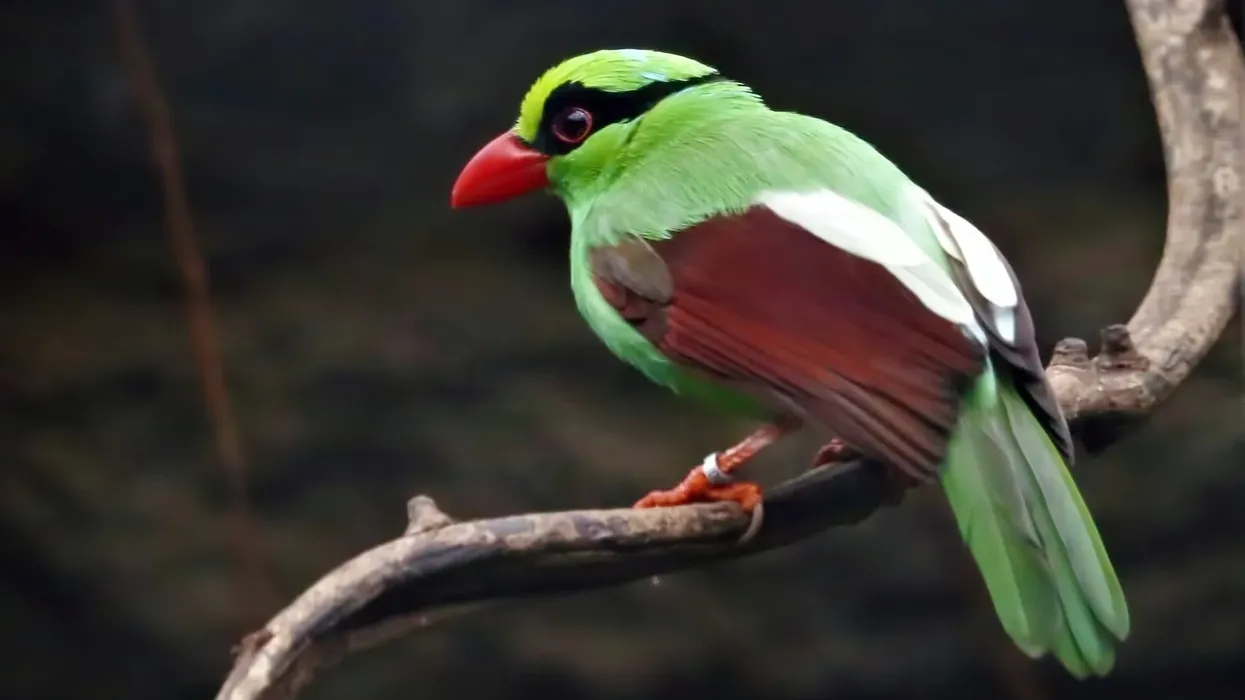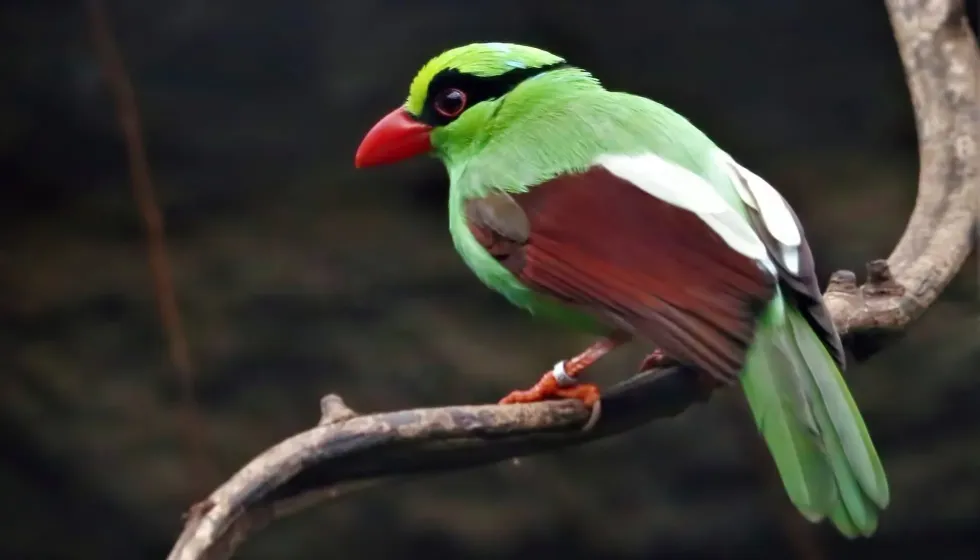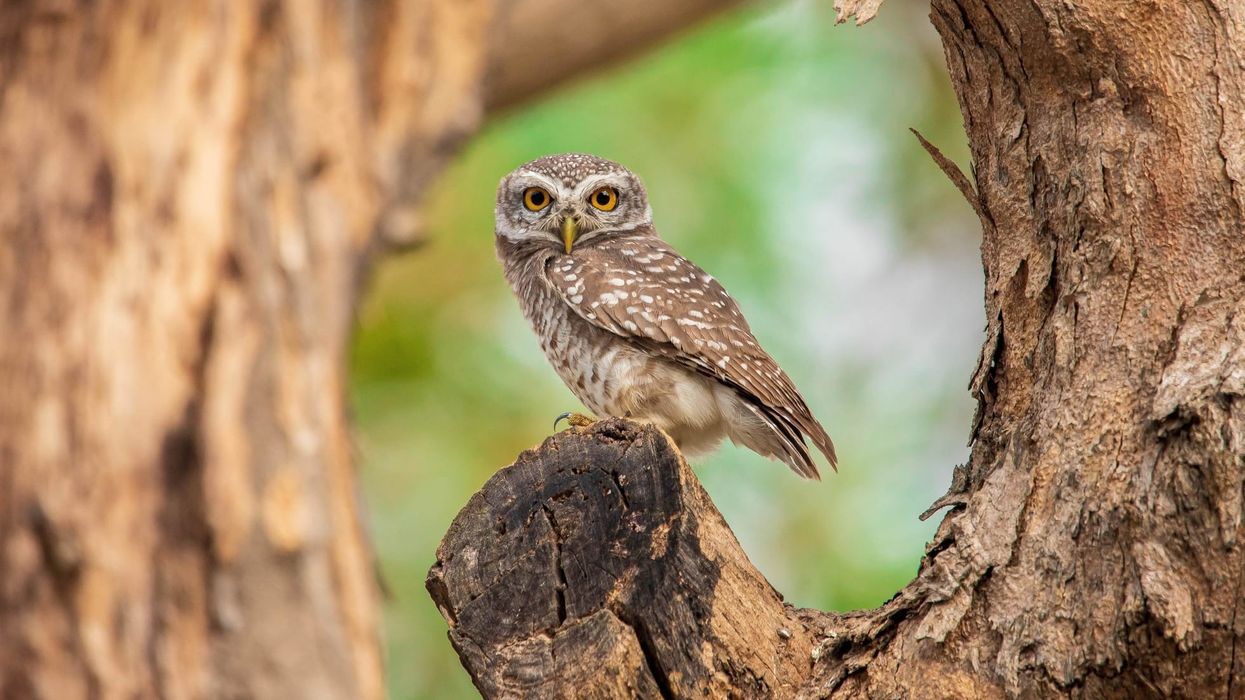The common green magpie (Cissa chinensis) is a type of magpie bird belonging to the genus Corvidae. It is found in any type of evergreen forest across southeast Asia, mainly in northeast India, Nepal, Bhutan, central Thailand, Malaysia, Sumatra, and Borneo.
These birds are known for their beautiful, vivid plumage and distinctive facial markings, which makes their appearance unique. They are far more striking and less aggressive than their commonly known cousin, the black and white magpie.
They are seen darting among the trees in low-lying forests and wetlands, constantly on the move searching for prey to satiate their carnivorous appetites. They are resident species, they do not migrate during the winter like other species of magpies do.
To learn more about these beautiful birds, read below. For more relatable content, check out these Australian magpie facts and azure winged magpie facts for kids.
The common green magpie (Cissa chinensis) is a type of magpie bird belonging to the genus Corvidae. It is found in any type of evergreen forest across southeast Asia, mainly in northeast India, Nepal, Bhutan, central Thailand, Malaysia, Sumatra, and Borneo.
These birds are known for their beautiful, vivid plumage and distinctive facial markings, which makes their appearance unique. They are far more striking and less aggressive than their commonly known cousin, the black and white magpie.
They are seen darting among the trees in low-lying forests and wetlands, constantly on the move searching for prey to satiate their carnivorous appetites. They are resident species, they do not migrate during the winter like other species of magpies do.
To learn more about these beautiful birds, read below. For more relatable content, check out these Australian magpie facts and azure winged magpie facts for kids.
Common Green Magpie Interesting Facts
What type of animal is a common green magpie?
The common green magpie (Cissa chinensis) is a type of brightly colored, noisy bird in the Corvidae family.
What class of animal does a common green magpie belong to?
The common green magpie bird (Cissa chinensis) belongs to the class of Aves.
How many common green magpies are there in the world?
The current population of the common green magpie bird species in the world is unknown. However, since this species is commonly available, the International Union for Conservation of Nature (IUCN) Red List has classified it as of Least Concern.
Where does a common green magpie live?
The common green magpie (Cissa chinensis) can commonly be found across the south Himalayan region, in northeast India, southern China, Nepal, and Bhutan. It is also found in Malaysia, central Thailand, Sumatra, and Borneo.
What is a common green magpie's habitat?
The common green magpie is commonly seen perching in subtropical montane evergreen forests, bamboo forests, scrublands, and clearings. It is also found near wetlands, streams, rivers, and waterfalls, in subtropical moist lowland climates.
Who does the common green magpie live with?
These magpies usually form mated pairs for life and live together in their nests.
How long does a common green magpie live?
Magpies are commonly known to live for 10-15 years. However, in rare cases, they can live up to 20 years of age!
How do they reproduce?
Magpies are known to form long-term mating pairs. Once paired off, these birds will construct their nest in high trees, large shrubs, or among tangled masses of vines, high off the ground. After the mating process, the female will lay four to six eggs in the nest, which will be incubated until the hatchlings are ready to be born.
What is their conservation status?
According to the International Union for Conservation of Nature (IUCN) Red List, these common green magpie (Cissa chinensis) birds are currently of Least Concern with regards to any threat of endangerment.
Common Green Magpie Fun Facts
What does the common green magpie look like?
Named after its bright green coloring, this bird species can surprisingly also be found in shades of vivid blue or turquoise. The plumage on their undersides is slightly duller than the rest of their bodies, and their wings are reddish-brown. Their tail and wing feathers are tipped with white, creating a beautiful pattern when spread out.
Their most defining feature, however, is the deep black band running across their striking orange eyes, till their bill. To complete the bird's unique look, their bill and legs are bright orange.
Despite their colorful appearance, these birds are very difficult to spot among the forest leaves, only visible as they dart from tree to tree.

How cute are they?
Contradictory to the evil reputation of magpies, this species is quite adorable looking with its colorful plumage and distinctive facial markings. Its feathers are especially fluffy, giving it a plush appearance.
How do they communicate?
Like all other magpies, the common green magpie call is very harsh and noisy. These magpies sound very loud, and can easily be identified due to the intensity of their crowing. Another common magpie sound is whistling and chattering.
How big is a common green magpie?
The common green magpie species measures between a range of 14.6-15.3 in (37-39 cm). They are nearly three times bigger than common kingfishers and nearly three times smaller than harpy eagles.
How fast can a common green magpie fly?
The common magpie bird can fly at speeds of 20 mph (32 kph).
How much does a common green magpie weigh?
Common green magpies usually weigh in a range of 4.6-6.3 oz (130-180 g).
What are the male and female names of the species?
There are no specific names given to males and females of this species, common magpies males and females simply being called cocks and hens respectively.
What would you call a baby common green magpie?
Baby common green magpies are called fledglings, hatchlings, or chicks.
What do they eat?
Common green magpie (Cissa chinensis) birds are strictly carnivorous in nature, hunting for prey in the sky and on the ground alike. They will mostly kill and eat small invertebrates, reptiles, mammals, and even other birds!
They often attack other bird species nests, stealing and eating their eggs. They have also been known to eat carrion crows, picking off carcasses of dead animals from the forest floor.
Are they dangerous?
It is unknown if this magpie species is as dangerous as its relative, the Australian black and white magpie species, which has been known to dive-bomb people and bombard them with painful pecks with its sharp bill.
Being a wild bird, it will definitely act in defense if provoked, however, otherwise, it is more dangerous to small animals and birds than to humans.
Would they make a good pet?
If born and brought up in captivity, this bird species can make quite good pets. However, it is not advised to capture these magpie birds from the wild in an attempt to train them.
Being highly social and accustomed to their natural habitat, these birds are often unable to survive in captivity. Since the common green magpie (Cissa chinensis) is a wild bird species, keeping it as a pet may be illegal in most cases as well.
Did you know...
This species has been observed to change the color of its feathers depending on its diet. If bred in captivity, it is bound to turn blue due to the lack of the nutrients found in its wild diet which keeps its plumage green.
Despite being pretty colorful, it is able to camouflage quite well in the forest.
This bird species is diurnal, so it hunts in the forest during the day and sleeps at night.
They belong to the same genus (Corvidae) as crows. The Corvidae genus is classified as a genus of songbirds.
Unlike their black and white relative, they build their own nests instead of laying their eggs in the nests of other birds.
They are not endemic to any region, being widely found in many South Asian countries.
Do magpies kill and eat other birds?
Yes, a number of small birds constitute a part of the green common magpie birds diet. Being highly carnivorous, this magpie will often kill and eat birds smaller than itself, as well as their eggs.
How many eggs do common green magpie lay?
This species builds its nests in tall trees, large shrubs, or tangled vines. Female green magpie birds lay around four to six eggs.
You can even occupy yourself at home by coloring in one of our free printable Taiwan blue magpie coloring pages.








